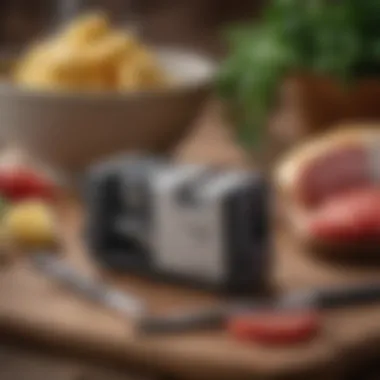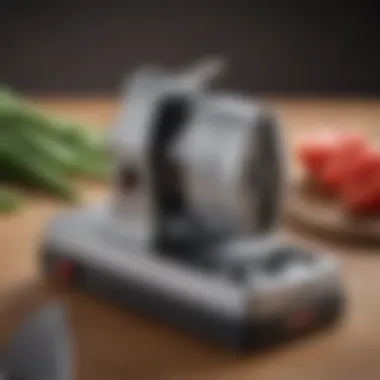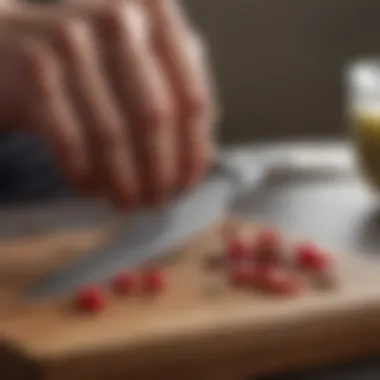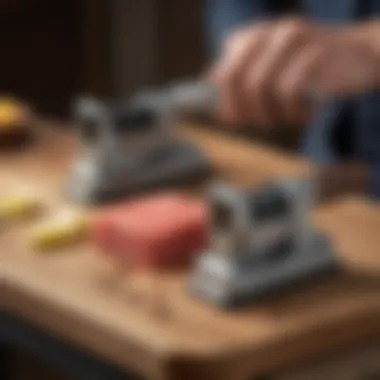Understanding the Best Wusthof Knife Sharpener


Intro
Selecting the right knife sharpener can significantly impact the performance of your Wusthof knives. In the culinary world, sharp knives are essential for precision and safety. A dull knife can be a hazard, leading to slips and accidents. Thus, understanding the various options available for knife sharpening is crucial for anyone who values quality in the kitchen.
In this article, we will explore the best Wusthof knife sharpeners on the market. We will examine the different types of sharpeners, their unique features, and the specific needs they address. Understanding these elements will help readers make informed decisions when it comes to maintaining their valuable kitchen tools.
The guide will cover several key areas. First, we will discuss the main types of Wusthof sharpeners available and their individual characteristics. Following that, we will analyze features that enhance the knife sharpening experience. In addition, we will provide tips on maintaining your knives for lasting performance.
Lastly, we will summarize the best practices for selecting a sharpener that aligns with your culinary needs. By the end of this guide, you will have a comprehensive understanding of the optimal sharpener for your Wusthof knives, enhancing both your cooking skills and equipment.
Prelude to Wusthof Knives
Wusthof knives are among the most esteemed tools in the culinary world. Established in 1814, this German brand has earned a reputation for its craftsmanship and commitment to quality. When considering a Wusthof knife, it is essential to understand the unique attributes that distinguish these tools. Each knife represents meticulous attention to detail, from the composition of the steel to the ergonomics of the handle. Furthermore, maintaining the sharpness of these knives is crucial, as dull blades can compromise safety and efficiency in the kitchen. In this section, we will explore the overall significance of the Wusthof brand and the critical importance of knife maintenance.
Overview of Wusthof Brand
Wusthof operates with a clear emphasis on tradition and excellence. Each Wusthof knife is manufactured in Solingen, Germany—often referred to as the "City of Blades." The brand prides itself on using high-carbon stainless steel, which is both durable and resistant to corrosion. The knives undergo precise forging processes, ensuring they maintain sharp edges through rigorous use.
Moreover, Wusthof’s design philosophy prioritizes balance and comfort. Each knife is carefully weighted to enhance user control, making the task of cutting, slicing, and chopping more efficient. For anyone serious about cooking, choosing a Wusthof knife can elevate the culinary experience.
Significance of Knife Maintenance
Proper knife maintenance is a practice that directly impacts both the longevity and functionality of kitchen tools. Keeping Wusthof knives sharp is not merely a matter of convenience but also crucial for safety. Dull knives can lead to accidents, as they require more force to cut through food, increasing the chance of slips and injuries.
Regular maintenance involves more than just sharpening. It includes honing, which realigns the knife’s edge, and cleaning, which prevents rust and bacteria build-up. Focusing on the maintenance of your Wusthof knives will ensure their performance remains optimal, allowing for precision and control in your culinary endeavors. A commitment to sustaining these knives can noticeably improve the quality of the meals prepared.
Investing time in knife maintenance reflects a commitment to culinary art.
Types of Knife Sharpeners
Understanding the different types of knife sharpeners is essential for maintaining the quality of Wusthof knives. Each type serves a unique purpose and comes with distinct benefits and considerations. Knowing these differences can help users select the right sharpener based on their needs, skill level, and preferences. This section explores three main categories of knife sharpeners: manual sharpeners, electric sharpeners, and honing rods.
Manual Sharpeners
Manual sharpeners offer a hands-on method of sharpening knives. They commonly include whetstones, sharpening stones, and handheld sharpeners. Users typically need to learn proper technique to achieve optimal results, but many find this process rewarding.
Benefits of Manual Sharpeners:
- Control: The user can dictate the angle and pressure applied, often leading to personalized sharpening.
- Versatility: Various types of stones allow sharpening to different levels of coarseness.
- Cost-Effective: Generally less expensive compared to electric options.
Considerations for Manual Sharpeners:
- Skill Level: Requires practice to master the technique.
- Time-Consuming: Sharpening can take longer than with electric options.
- Portability: Often lightweight and easy to store, making them suitable for travel.
Electric Sharpeners
Electric sharpeners are convenient tools designed for efficiency and speed. Typically, they have built-in guides to help users achieve the correct sharpening angle quickly. For those who seek fast results, electric sharpeners can be an appealing choice.
Benefits of Electric Sharpeners:
- Speed: Sharpening is often completed in seconds, making it ideal for busy kitchens.
- Consistency: They usually provide uniform results, as the machine handles the angle and pressure.
- Ease of Use: Minimal learning curve makes them accessible even for beginners.
Considerations for Electric Sharpeners:
- Cost: Often pricier than manual options.
- Dependence on Power: Requires an electrical outlet, restricting portability.
- Potential Damage: Over-sharpening can occur, risking blade integrity.


Honing Rods
Honing rods, also known as honing steels, are not technically sharpeners but maintain the sharpness of knives. These tools help realign the microscopic edges of blades, keeping them in optimal condition between regular sharpening sessions. They are a staple in many professional kitchens.
Benefits of Honing Rods:
- Maintenance: Regular use prevents the need for frequent sharpening, prolonging blade life.
- Quick and Easy: Using a honing rod is a swift process, making it convenient for everyday use.
- Immediate Results: Helps achieve a sharper edge immediately without extensive effort.
Considerations for Honing Rods:
- Limited Effect: Only effective for maintaining already sharp knives; not for restoring dull edges.
- Technique Matters: Users must learn the correct approach for effective honing.
- Material Quality: The quality of the honing rod itself can vary, influencing effectiveness.
Keep in mind that the right sharpener varies by individual needs and preferences. Understanding each type of sharpener can greatly enhance the performance of your Wusthof knives.
Features of Wusthof Knife Sharpeners
When choosing a knife sharpener, particularly for Wusthof knives, understanding the features is essential. Each feature contributes to the sharpening process, enhancing the knife's performance and longevity. Wusthof sharpeners are designed to cater to different user needs, bringing together various characteristics that can influence the effectiveness of sharpening. This section will discuss critical elements including sharpening angles, material quality, and portability and design.
Sharpening Angles
The sharpening angle is a fundamental aspect of any knife sharpener. Wusthof knives generally have a specific edge angle to maintain optimal cutting performance. Most Wusthof knives are sharpened at a 14-degree angle per side, creating a total edge angle of 28 degrees.
Using a sharpener that accommodates this angle is important for preserving the knife's original design. If a sharpener is used that does not match this angle, it could alter the blade's geometry, potentially leading to reduced effectiveness. Therefore, choosing a sharpener with adjustable angles can be beneficial for users who own different knife styles.
"Choosing the right sharpening angle is crucial for maintaining the precision of your knife."
Material Quality
The materials used in the construction of knife sharpeners play a significant role in their performance. Wusthof sharpeners typically feature high-quality materials that are both durable and effective at sharpening.
Common materials include diamond abrasives, ceramic, and steel. Diamond abrasives, known for their hardness, provide efficient sharpening. Ceramic wheels promote a fine edge, making them ideal for finishing touches. Steel sharpeners are often used for honing, helping to realign the knife edge without removing much material. Each material serves a different purpose, depending on what stage of sharpening or maintenance is needed.
Additionally, the quality of the construction of the sharpener affects its longevity. A well-constructed sharpener can withstand frequent use, making it a wise investment for culinary enthusiasts.
Portability and Design
Portability is another essential factor when selecting a Wusthof knife sharpener. Depending on the user�’s needs, a compact design may be more practical. Some sharpeners are designed for counter use, while others offer great portability for those who like to sharpen on the go.
An effective sharpener should also be easy to use. User-friendly designs decrease the likelihood of accidents and ensure that anyone can achieve a sharpened edge without extensive training. For instance, electric sharpeners tend to offer user-friendly interfaces, while manual sharpeners often require a bit more skill but provide greater control.
Overall, a good design should balance functionality with ease of use, ensuring that anyone can maintain their Wusthof knives effectively.
Top Wusthof Knife Sharpeners
When it comes to maintaining the performance of your Wusthof knives, selecting the right sharpener is crucial. The best Wusthof knife sharpeners are tailored to optimize the longevity and cutting efficiency of these high-quality knives. Given the variety of sharpening methods available, it is essential to understand which sharpener suits your needs. This section will delve into three noteworthy Wusthof sharpeners, providing insight into each option’s benefits and unique features.
Wusthof Precision Edge
The Wusthof Precision Edge II is a manual sharpener designed for both novices and seasoned chefs. It incorporates a two-stage sharpening system, which allows for effective honing and sharpening of the knives. The initial sharpening stage utilizes a diamond abrasive to shape the blade edge efficiently. The second stage employs a ceramic wheel to finely polish the edge, resulting in a sharper finish. This two-step process promotes precise sharpening, ensuring that your knives maintain optimal performance for various culinary tasks.
This sharpener is especially beneficial for those who appreciate control during the sharpening process. The ergonomic design provides comfort while minimizing hand fatigue. The compact nature makes it easy to store in a drawer or on a countertop. Users also benefit from the clarity of angle guides, ensuring consistent sharpening every time.
Wusthof Electric Sharpener
For those who prefer a quicker method, the Wusthof Electric Sharpener delivers exceptional convenience without compromising knife quality. This electric sharpener features advanced sharpening technology that automatically adjusts the sharpening angle for different knife types.


The electric sharpener boasts two independent sharpening slots. The first slot is specifically designed for rough sharpening, using diamond abrasives to reshape worn blades. The second slot uses ceramic wheels for touch-ups, accommodating regular maintenance needs. The speed of the sharpening process can be particularly appealing for busy kitchens where efficiency is key. The Wusthof Electric Sharpener is also designed for a variety of knife types, making it versatile for any knife collection.
Wusthof Classic Honing Steel
The Wusthof Classic Honing Steel is a vital tool for maintaining knife sharpness between full sharpenings. Unlike traditional sharpeners that reshape the blade, honing steels realign the microscopic teeth of the blade. This process ensures that knives remain functional over extended periods.
This honing steel is crafted from high-carbon stainless steel, providing durability and reliability. It also features a textured handle for a firm grip, allowing for comfortable and safe use. Regular honing can effectively extend the life of a Wusthof knife, preventing the need for frequent sharpening. This makes it an essential accessory for those who want to keep their knives in peak condition.
"Maintaining your Wusthof knife’s edge with the appropriate sharpener can significantly enhance your culinary experience."
In summary, each sharpener offers distinct benefits tailored to different sharpening needs. From manual precision to convenient electric options and effective honing, choosing the right Wusthof sharpener helps ensure your knives perform at their best.
Comparison of Wusthof Sharpeners
Understanding the differences between manual and electric Wusthof knife sharpeners is crucial. This comparison not only highlights the pros and cons of each option but also helps users make informed decisions based on their specific needs. Choosing the right sharpener can significantly influence the effectiveness of maintaining the knife's edge.
Manual vs. Electric Sharpeners
Manual sharpeners, like the Wusthof Precision Edge II, provide a tactile experience. Users have complete control over the sharpening angle and pressure applied. This method can be preferable for individuals who enjoy the process of sharpening their knives. Notably, they often require no electricity, making them portable and easy to use in various settings. However, this means that skill and practice are required to achieve optimal results.
On the other hand, electric sharpeners, such as the Wusthof Electric Sharpener, simplify the process significantly. Users can achieve consistent results with minimal effort. This can be especially beneficial for those who lack experience or confidence in sharpening knives. Electric sharpeners often have built-in guides that ensure the correct angles are maintained, ensuring a sharpened edge consistently every time.
In essence, the choice between manual and electric sharpeners often depends on the user's experience level and preferences. Manual sharpeners define the sharpening experience and offer a sense of craftsmanship. Meanwhile, electric models prioritize convenience and consistency, making them an attractive option for those seeking efficiency.
Effectiveness and Ease of Use
Effectiveness in sharpening arises from both the method chosen and the specific sharpener. Manual sharpeners require the user's input in terms of technique. A knowledgeable user can hone their skills to achieve excellent results. Yet, if improperly used, they might not sharpen knives effectively enough, leading to frustration.
Meanwhile, electric sharpeners excel in ease of use. Anyone can quickly learn to use these devices, regardless of their prior experience in knife care. Consistency is a hallmark of electric sharpeners, as they eliminate variables often present in manual sharpening methods. Users can expect uniformly sharpened knives with less chances of damaging the blade.
A careful evaluation is necessary to match sharpening preferences. For culinary enthusiasts keen on honing their skills, manual options might be the way to go. In contrast, for busy home cooks or professionals looking for consistent results without sacrificing time or effort, electric sharpeners present a compelling alternative. Each has its merits, and understanding them ensures you select the sharpener best suited for your culinary needs.
"A well-maintained knife not only performs better but also enhances safety during food preparation."
Ultimately, a well-informed comparison helps knife owners appreciate the strengths of different sharpeners. With clarity on the unique qualities of each Wusthof sharpener type, users can feel confident in their decision-making, ensuring each knife performs optimally for various culinary applications.
Considerations for Choosing a Sharpener
The process of selecting the right sharpener for your Wusthof knives is essential for maintaining their performance. A well-chosen sharpener not only extends the life of the knife but also enhances your overall cooking experience. Knowing how to match a sharpener to your specific needs ensures that you achieve optimum cutting performance.
Knife Type and Usage
Different types of Wusthof knives serve varied functions. For example, a chef's knife may require a different sharpening approach than a paring knife. Understanding the specific knife type is crucial. A serrated knife, for instance, should not be sharpened with a standard sharpener designed for straight blades. Instead, consider using a specialized serrated knife sharpener to maintain the integrity of the blade.
Furthermore, think about how often you use each knife. Heavy-duty, frequently used knives might benefit from a robust sharpening system that can withstand regular wear and tear. Meanwhile, specialty knives that are used less often may only need occasional touch-ups with a simpler tool. By considering both knife type and usage, you can select a sharpener that ensures better edge retention and longevity.
Frequency of Use
Your sharpening strategy should correspond to your frequency of knife use. Regular cooks may find themselves needing to sharpen their knives more often. Wusthof knives are known for their quality, yet they still benefit from consistent maintenance.
If you use your knives daily, a reliable electric sharpener may be beneficial, given its efficiency and ease of use. It can quickly restore the edge on a dull knife. In contrast, those who use their knives less frequently might opt for manual sharpeners, which can provide a more hands-on sharpening experience without the need for regular investment in an electric model.
Thus, assess how often you engage with your knives, and choose accordingly. This will save time and ensure optimal performance when cooking.
Budget Constraints


Budget considerations play a significant role in the selection of a knife sharpener. Price can vary dramatically among sharpeners, from basic manual models to advanced electric options with multiple features. Determine how much you are willing to invest in a sharpener while considering the frequency of use and the overall investment in your knife collection.
Typically, lower-priced models may be suitable for occasional users or those who own fewer knives. However, if you frequently cook or possess a variety of Wusthof knives, investing in a high-quality electric sharpener may provide better value in the long term.
In summary, balancing your budget with expected quality and functionality is essential.
Key Takeaway: Choosing the best sharpener requires careful consideration of knife type, usage frequency, and budget constraints. Each element directly impacts your sharpening outcomes, helping you maintain the precision of your Wusthof knives.
Maintenance of Wusthof Knives
The efficiency and longevity of Wusthof knives significantly depend on proper maintenance. Understanding how to maintain these knives is crucial for any culinary enthusiast. Regular sharpening, cleaning, and care are paramount in ensuring that Wusthof knives perform their best over time. By focusing on these aspects, users can maximize the utility of their investment in high-quality kitchen tools.
Regular Honing
Honing is a critical aspect of maintaining Wusthof knives. It helps maintain the knife's edge by realigning the blade's microscopic teeth. Unlike sharpening, which removes material from the knife, honing simply straightens the edge without altering its shape. Regularly honing your Wusthof knife after each use is advisable. This habit can help preserve cutting precision and enhance the overall performance of the blade.
Using a honing rod, such as the Wusthof Classic Honing Steel, can be a straightforward process. Hold the honing rod vertically and position the knife at around a 15-degree angle against the rod. Gently swipe the blade down the rod, alternating sides as you go. This technique not only helps keep the edge aligned but also prolongs the interval between necessary sharpenings. An effective honing routine can contribute significantly to the longevity of your knife.
Cleaning and Care
Cleaning and caring for Wusthof knives are crucial steps in maintaining their functionality. Proper cleaning prevents the build-up of food particles and bacteria, enhancing safety and hygiene in food preparation. After each use, rinse the blade under hot water and wipe it with a soft sponge. Avoid using abrasive materials, which can scratch or damage the finish of the knife.
Drying the knife immediately after washing is essential to prevent rust or corrosion, especially on the high-carbon steel models. A soft cloth is the best option for drying. Store Wusthof knives in a designated block or magnetic strip, ensuring their blades do not come into contact with other utensils. This practice helps maintain the sharpness and avoids damage to the edges.
"Proper maintenance makes Wusthof knives reliable partners in the kitchen. Investing time in honing and cleaning will yield benefits in performance and longevity."
Impacts of Proper Sharpening Techniques
Proper sharpening techniques have significant impacts on knife performance and safety, particularly when working with high-quality knives like those from Wusthof. Knife sharpness is critical not only for culinary precision but also for ensuring a safe cooking environment. When a knife is properly sharpened, it requires less force to cut through ingredients, which can reduce the risk of slips and accidents in the kitchen. Additionally, well-maintained knives provide consistent cutting outcomes, creating uniform slices that enhance the presentation of dishes.
An aspect often overlooked in discussions about sharpening is the long-term care and prolonged lifespan of the knife. A sharp knife reduces wear and tear on the blade, which can prolong its professional performance and contribute to overall kitchen efficiency. Moreover, using a sharp knife also minimizes frustration, allowing the cook to focus more on the dish rather than the tool.
Enhanced Cutting Precision
When a Wusthof knife is sharp, it operates with enhanced precision. This increased sharpness allows for clean cuts, which is vital for various culinary tasks. Whether slicing vegetables, filleting fish, or carving meat, the quality of the cut will directly influence the final dish. A sharp blade maintains the texture and integrity of the food, ensuring that flavors remain unaltered. This precision is crucial, especially when dealing with delicate ingredients that could potentially bruise or break if subjected to excessive pressure.
Proper sharpening techniques also contribute to the blade’s angle and edge retention. A keen edge angle ensures that the knife glides through ingredients rather than tearing them, resulting in better aesthetics and taste. A sharp knife, therefore, not only enhances individual cooking efforts but also impacts the overall dining experience.
Safety Considerations
Safety in the kitchen cannot be understated, and the role of knife sharpness is pivotal in this regard. Contrary to popular belief, dull knives pose a greater danger than sharp ones. With a dull knife, a cook often exerts more force to achieve a cut, increasing the likelihood of accidental slips and injuries. A sharp Wusthof knife allows for more controlled movements and significantly reduces this risk.
Furthermore, maintaining sharpness requires regular honing and proper sharpening techniques. Without these practices, blades can develop problems such as chips or uneven edges, which can lead to unexpected and dangerous situations. A regular check on knife condition and appropriate sharpening will ensure that each tool is ready to perform safely, allowing cooks to concentrate on their culinary creations rather than potential hazards.
"A well-maintained knife is not just a tool; it is a guardian against kitchen accidents."
Ending
In this article, we have explored various dimensions of Wusthof knife sharpeners. Understanding the best sharpener is crucial for maintaining the sharpness and durability of your Wusthof knives. A sharp knife enhances performance in the kitchen, allowing for more precise cuts and safer handling. Selecting the right sharpener not only contributes to the lifespan of the knife but also ensures that each slice is clean and effortless.
Summary of Key Points
- Types of Sharpeners: We discussed manual and electric sharpeners, each with its benefits. Manual sharpeners provide a hands-on approach, while electric sharpeners offer speed and consistency.
- Features: Key elements to look for include sharpening angles, material quality, and the portability of the sharpener. These aspects directly influence the effectiveness of the sharpening process.
- Comparison: A comparison between manual and electric options highlighted their respective ease of use and sharpening effectiveness, guiding the reader in making an informed choice based on their needs.
- Maintenance: Regular honing and proper care are essential to maintain the performance of Wusthof knives. This upkeep allows for long-lasting precision in the kitchen.
- Considerations: Personal requirements, such as the type of knife, frequency of use, and budget constraints, should always guide the selection process.
Final Recommendations
Choosing the right sharpener depends on individual preferences and usage scenarios. For those who appreciate hands-on control, the Wusthof Precision Edge II manual sharpener is an excellent choice. It is effective and offers an engaging experience. On the other hand, if convenience is paramount, the Wusthof Electric Sharpener may be the better option, ensuring a consistently sharp edge with minimal effort.
Furthermore, investing in a honing rod, like the Wusthof Classic Honing Steel, can be a valuable addition. It allows for regular maintenance, potentially prolonging the sharpness of your knives between major sharpenings.
In summary, selecting a sharpener is not merely a matter of preference but a thoughtful decision that impacts culinary performance. Equip yourself with the right tools and maintain them correctly to ensure that your Wusthof knives continue to serve you well in the kitchen.















